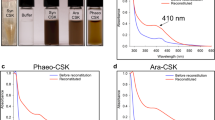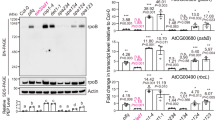Abstract
Redox chemistry—the transfer of electrons or hydrogen atoms—is central to energy conversion in respiration and photosynthesis. In photosynthesis in chloroplasts, two separate, light-driven reactions, termed photosystem I and photosystem II, are connected in series by a chain of electron carriers1,2,3. The redox state of one connecting electron carrier, plastoquinone, governs the distribution of absorbed light energy between photosystems I and II by controlling the phosphorylation of a mobile, light-harvesting, pigment–protein complex4,5. Here we show that the redox state of plastoquinone also controls the rate of transcription of genes encoding reaction-centre apoproteins of photosystem I and photosystem II. As a result of this control, the stoichiometry between the two photosystems changes in a way that counteracts the inefficiency produced when either photosystem limits the rate of the other. In eukaryotes, these reaction-centre proteins are encoded universally within the chloroplast. Photosynthetic control of chloroplast gene expression indicates an evolutionary explanation for this rule: the redox signal-transduction pathway can be short, the response rapid, and the control direct.
This is a preview of subscription content, access via your institution
Access options
Subscribe to this journal
Receive 51 print issues and online access
$199.00 per year
only $3.90 per issue
Buy this article
- Purchase on Springer Link
- Instant access to full article PDF
Prices may be subject to local taxes which are calculated during checkout




Similar content being viewed by others
References
Hill, R. & Bendall, F. Function of the two cytochrome components in chloroplasts, a working hypothesis. Nature 186, 136–137 (1960).
Duysens, L. N. M. & Amesz, J. Function and identification of two photochemical systems in photosynthesis. Biochim. Biophys. Acta 64. 243–260 (1962).
Myers, J. Enhancement studies in photosynthesis. Annu. Rev. Plant Physiol. 22, 289–312 (1971).
Allen, J. F., Bennett, J., Steinback, K. E. & Arntzen, C. J. Chloroplast protein phosphorylation couples plastoquinone redox state to distribution of excitation energy between photosystems. Nature 291, 25–29 (1981).
Allen, J. F. Protein phosphorylation in regulation of photosynthesis. Biochim. Biophys. Acta 1098, 275–335 (1992).
Hiyama, T. & Ke, B. Difference spectra and extinction coefficients of P700. Biochem. Biophys. Acta 267, 160–171 (1972).
van Gorkom, H. J. Identification of the reduced primary electron acceptor of photosystem II as a bound semiquinone anion. Biochim. Biophys. Acta 347, 439–442 (1974).
Trebst, A. Inhibitors in electron flow: tools for the functional and structural localization of carriers and energy conservation sites. Methods Enzymol. 69, 675–715 (1980).
Danon, A. & Mayfield, S. P. Light-regulated translation of chloroplast messenger RNAs through redox potential. Science 266, 1717–1719 (1994).
Escoubas, J. -M., Loumas, M., LaRoche, J. & Falkowski, P. G. Light intensity regulation of cab gene transcription is signaled by the redox state of the plastoquinone pool. Proc. Natl Acad. Sci. USA 92, 10237–10241 (1995).
Maxwell, D. P., Laudenbach, D. E. & Huner, N. P. A. Redox regulation of light-harvesting complex II and cab mRNA abundance in Dunaliella salina. Plant Physiol. 109, 787–795 (1995).
Karpinski, S., Escobar, C., Karpinski, B., Creissen, G. & Mullineaux, P. M. Photosynthetic electron transport regulates the expression of cytosolic ascorbate peroxidase genes in Arabidopsis during excess light stress. Plant Cell 9, 627–640 (1997).
Allen, C. A., Håkansson, G. & Allen, J. F. Redox conditions specify the proteins synthesised by isolated chloroplasts and mitochondria. Redox Report 1, 119–123 (1995).
Fujita, Y., Murakami, A. & Ohki, K. Regulation of photosystem composition in the cyanobacterial photosynthetic system: the regulation occurs in response to the redox state of the electron pool located between the two photosystems. Plant Cell Physiol. 28, 283–292 (1987).
Whatley, J. M., John, P. & Whatley, F. R. From extracellular to intracellular: the establishment of mitochondria and chloroplasts. Proc. R. Soc. Lond. B 204, 165–187 (1979).
Cavalier-Smith, T. The simultaneous symbiotic origin of mitochondria, chloroplasts, and microbodies. Ann. NY Acad. Sci. 503, 55–71 (1987).
Martin, W. & Müller, M. The hydrogen hypothesis for the first eukaryote. Nature 392, 37–41 (1998).
Ellis, R. J. The nuclear domination of chloroplast development. Sci. Prog. Oxf. 69, 129–142 (1984).
Attardi, G. & Schatz, G. Biogenesis of mitochondria. Annu. Rev. Cell Biol. 4, 289–333 (1988).
Allen, J. F. Control of gene expression by redox potential and the requirement for chloroplast and mitochondrial genomes. J. Theor. Biol. 165, 609–631 (1993).
Allen, J. F. & Raven, J. A. Free-radical-induced mutation vs redox regulation: costs and benefits of genes in organelles. J. Mol. Evol. 42, 482–492 (1996).
Allen, J. F., Mullineaux, C. W., Sanders, C. E. & Melis, A. State transitions, photosystem stoichiometry adjustment and non-photochemical quenching in cyanobacterial cells acclimated to light absorbed by photosystem I or photosystem II. Photosynth. Res. 22, 157–166 (1989).
Walker, D. A. Chloroplast (and grana): aqueous (including high carbon fixation ability). Methods Enzymol. 23, 211–220 (1971).
Melis, A. & Brown, J. S. Stoichiometry of system I and system II reaction centres and of plastoquinone in different photosynthetic membranes. Proc. Natl Acad. Sci. USA 77, 4712–4716 (1980).
Porra, R. J., Thompson, W. A. & Kriedemann, P. E. Determination of accurate extinction coefficients and simultaneous equations for assaying chlorophylls a and b extracted with four different solvents: verification of the concentration of chlorophyll standards by atomic absorption spectroscopy. Biochim. Biophys. Acta 975, 384–394 (1989).
Mullet, J. E. & Klein, R. R. Transcription and RNA stability are important determinants of higher plant chloroplast RNA levels. EMBO J. 6, 1571–1579 (1987).
Dietrich, G., Detschey, S., Neuhaus, H. & Link, G. Temporal and light control of plastid transcript levels for proteins involved in photosynthesis during mustard (Sinapis alba L.) seedling development. Planta 172, 393–399 (1987).
Link, G. Cloning and mapping of the chloroplast DNA sequences for two messenger RNAs from mustard (Sinapis alba L.). Nucleic Acids Res. 9, 3681–3694 (1981).
Pfannschmidt, T. & Link, G. The A and B forms of plastid DNA-dependent RNA polymerase from mustard (Sinapis alba L.) transcribe the same genes in a different developmental context. Mol. Gen. Genet. 257, 35–44 (1997).
Sambrook, J., Fritsch, E. F. & Maniatis, T. Molecular Cloning: A Laboratory Manual (Cold Spring Harbor Laboratory Press, (1989)).
Acknowledgements
We thank G. Link for discussions and for providing mustard seeds and DNA probes, and A. Tullberg for assistance with the experiments on isolated chloroplasts. This work was supported by the Swedish Natural Sciences Research Council and the Swedish Council for Co-ordination and Planning of Research. T.P. was the recipient of a postdoctoral fellowship of the Deutsche Forschungsgemeinschaft.
Author information
Authors and Affiliations
Corresponding author
Rights and permissions
About this article
Cite this article
Pfannschmidt, T., Nilsson, A. & Allen, J. Photosynthetic control of chloroplast gene expression. Nature 397, 625–628 (1999). https://doi.org/10.1038/17624
Received:
Accepted:
Issue Date:
DOI: https://doi.org/10.1038/17624
This article is cited by
-
Proximity to Photosystem II is necessary for activation of Plastid Terminal Oxidase (PTOX) for photoprotection
Nature Communications (2024)
-
Salinity-induced changes in plastoquinone pool redox state in halophytic Mesembryanthemum crystallinum L.
Scientific Reports (2023)
-
Insights into the changes in leaf functional traits of Aralia elata grown under different shading treatments
Plant Growth Regulation (2023)
-
Plastoquinone pool redox state and control of state transitions in Chlamydomonas reinhardtii in darkness and under illumination
Photosynthesis Research (2023)
-
Photosystem stoichiometry adjustment is a photoreceptor-mediated process in Arabidopsis
Scientific Reports (2022)
Comments
By submitting a comment you agree to abide by our Terms and Community Guidelines. If you find something abusive or that does not comply with our terms or guidelines please flag it as inappropriate.



